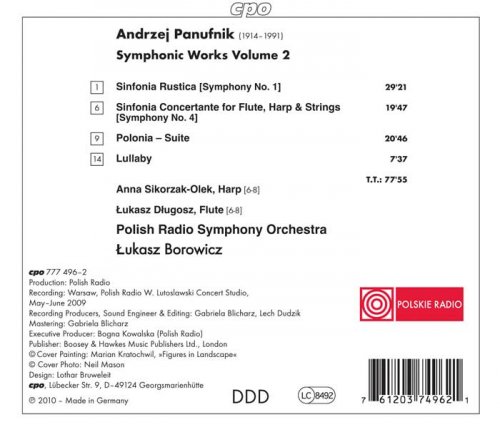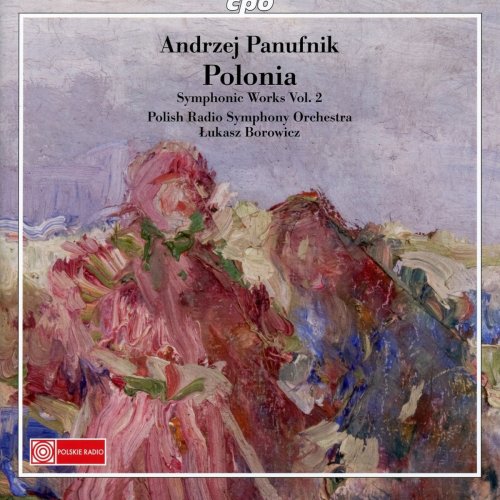
Polish Radio Symphony Orchestra - Panufnik: Symphonic Works, Vol. 2 (2014)
BAND/ARTIST: Polish Radio Symphony Orchestra
- Title: Panufnik: Symphonic Works, Vol. 2
- Year Of Release: 2014
- Label: CPO
- Genre: Classical
- Quality: FLAC (tracks)
- Total Time: 76:48 min
- Total Size: 320 MB
- WebSite: Album Preview

Tracklist:
01. I. Con tenerezza: Allegro moderato
02. II. Con grazia: Allegretto
03. III. Con espressione: Adagio
04. IV. Con vigore: Allegro
05. III. Con espressione: Adagio (first version)
06. I. Molto cantabile -
07. II. Molto ritmico -
08. Postscriptum
09. I. Marsz goralski
10. II. Mazurek
11. III. Krakowiak
12. IV. Piesn Nadwislanska
13. V. Oberek
14. Kolysanka (Lullaby)
Andrzej Panufnik (1914–91) fled his native Poland after the Second World War and settled in England in 1954. During the German occupation of Warsaw all his existing manuscripts were destroyed, including two completed symphonies. He reconstructed some pieces from memory, such as the Tragic Overture , but the Sinfonia Rustica , designated Symphony No. 1, was in fact his third. This excellent cpo series concentrates on what we think of as Panufnik’s early works, but as we see, they are by no means immature.
The music he composed in the 1950s and 60s was influenced by Polish folk melodies and liturgical chants. The Sinfonia Rustica, Polonia Suite and Lullaby all fall within this period. By the time of the Sinfonia Concertante for flute, harp, and 12 solo strings of 1973, he was moving away from a nationalistic style toward a systemic, almost geometrical approach to composition, the basis for all his late music. While fine craftsmanship and imaginative textures are common to Panufnik’s entire output, his earlier works remain the most popular—perhaps because traditional Polish melodies use a mode that is strikingly similar to the blues scale, giving the music an unintended jazz coloring. This disc is the second in cpo’s Panufnik series and there will undoubtedly be more to follow. We badly need a modern recording of his second symphony, the Sinfonia Elegiaca.
Sinfonia Rustica was written in 1948 and slightly revised in 1955 in order for Boosey and Hawkes to publish it, after the “non-person” composer was no longer able to receive royalties from his Polish publishers. (Stravinsky revised his early Russian ballets for publication in America for the same reason.) In fact, at a meeting of the Composers’ Union in 1950, the Polish Deputy Minister of Culture and Art, Wladimierz Sikorski, declared that the Sinfonia Rustica had “ceased to exist.” Well, here we are half a century later and the work is alive and well, while it is Sikorski and his regime that have ceased to exist.
There is a spatial element to the symphony. The orchestra is laid out symmetrically, with flute, two oboes, two bassoons, two horns, and trumpet in the center, and a string orchestra on either side. Panufnik makes much use of antiphonal effects with this setup. In four movements, all refering to northern Polish folk music, the symphony is a joyously colorful work, turning graphically terpsichorean when the trumpet or horns are required to give an upward glissando whoop! I have loved this music since I first heard the HMV LP of the composer’s performance with the Monte Carlo Opera Orchestra, made in 1967. (More of that recording anon.) The CD under review includes an extra track of the third movement in its original form, with an introductory passage that the composer later jettisoned.
Polonia , an orchestral suite from 1959, gives the disc its title. In six movements, this suite alternates vigorous Polish dances with pensive, lyrical episodes. The closing Oberek is brilliantly energetic, and practically orgiastic by the end. This is the most spirited work of Panufnik that I know: It is his go at light music, written for him to conduct at the Proms as a companion piece to the considerably more subdued Polonia by Edward Elgar. Yet there is subtext here, just as there is in some of the light music of Shostakovich: a scarcely concealed anger beneath the revelry and a sense of loss underlying the gentle moments. The latter quality is even stronger in the Lullaby (1949) for strings and two harps. The harps’ rocking figure continues uneasily through misty string textures; the atmosphere, far from being reassuring, is one of quiet anxiety. This brief piece, which closes the disc, stays with you long after it has finished.
The austere Sinfonia Concertante is in two movements, slow ( molto cantabile ) and fast ( molto ritmico ), plus a short postscriptum . Energy picks up with the second movement, but the first is little more than 10 minutes of “what goes up must come down” arpeggio figures against sparse string textures: evidence of the composer’s growing obsession with symmetry. There is a quiet intensity here, and attractively limpid sonorities, but the piece demands tonal purity and sharp concentration from the soloists if it is not to outstay its welcome. Of the three performances I know, this one with Dlugosz and Sikorzak-Olek is the most successful.
The cpo release is definitely recommended, but competition exists from the composer himself in the two symphonies. The recording of Sinfonia Rustica I mentioned above was long available on a deleted Unicorn CD, but reappeared in 2006 on a low-priced EMI disc, along with its original companion piece, the Sinfonia Sacra , and a 1975 recording of the Sinfonia Concertante with distinguished soloists Aurèle Nicolet and Osian Ellis. (This disc is available from amazon.co.uk.) Panufnik emphasizes the spatial element in Sinfonia Rustica , with the two string bodies widely separated. His Monte Carlo band may boast scrawny strings and reedy oboes, but they attack the music with panache and commitment.
Borowicz’s Polish radio forces are fuller, more integrated, and given a lusher recording; similarly the extra space around the flute and harp in Borowicz’s Sinfonia Concertante adds an ethereal element that sounds both beguiling and appropriate. The Polish Radio Symphony Orchestra musicians go to town in the extrovert passages of Polonia ; the new disc is worth getting for that work alone.
The music he composed in the 1950s and 60s was influenced by Polish folk melodies and liturgical chants. The Sinfonia Rustica, Polonia Suite and Lullaby all fall within this period. By the time of the Sinfonia Concertante for flute, harp, and 12 solo strings of 1973, he was moving away from a nationalistic style toward a systemic, almost geometrical approach to composition, the basis for all his late music. While fine craftsmanship and imaginative textures are common to Panufnik’s entire output, his earlier works remain the most popular—perhaps because traditional Polish melodies use a mode that is strikingly similar to the blues scale, giving the music an unintended jazz coloring. This disc is the second in cpo’s Panufnik series and there will undoubtedly be more to follow. We badly need a modern recording of his second symphony, the Sinfonia Elegiaca.
Sinfonia Rustica was written in 1948 and slightly revised in 1955 in order for Boosey and Hawkes to publish it, after the “non-person” composer was no longer able to receive royalties from his Polish publishers. (Stravinsky revised his early Russian ballets for publication in America for the same reason.) In fact, at a meeting of the Composers’ Union in 1950, the Polish Deputy Minister of Culture and Art, Wladimierz Sikorski, declared that the Sinfonia Rustica had “ceased to exist.” Well, here we are half a century later and the work is alive and well, while it is Sikorski and his regime that have ceased to exist.
There is a spatial element to the symphony. The orchestra is laid out symmetrically, with flute, two oboes, two bassoons, two horns, and trumpet in the center, and a string orchestra on either side. Panufnik makes much use of antiphonal effects with this setup. In four movements, all refering to northern Polish folk music, the symphony is a joyously colorful work, turning graphically terpsichorean when the trumpet or horns are required to give an upward glissando whoop! I have loved this music since I first heard the HMV LP of the composer’s performance with the Monte Carlo Opera Orchestra, made in 1967. (More of that recording anon.) The CD under review includes an extra track of the third movement in its original form, with an introductory passage that the composer later jettisoned.
Polonia , an orchestral suite from 1959, gives the disc its title. In six movements, this suite alternates vigorous Polish dances with pensive, lyrical episodes. The closing Oberek is brilliantly energetic, and practically orgiastic by the end. This is the most spirited work of Panufnik that I know: It is his go at light music, written for him to conduct at the Proms as a companion piece to the considerably more subdued Polonia by Edward Elgar. Yet there is subtext here, just as there is in some of the light music of Shostakovich: a scarcely concealed anger beneath the revelry and a sense of loss underlying the gentle moments. The latter quality is even stronger in the Lullaby (1949) for strings and two harps. The harps’ rocking figure continues uneasily through misty string textures; the atmosphere, far from being reassuring, is one of quiet anxiety. This brief piece, which closes the disc, stays with you long after it has finished.
The austere Sinfonia Concertante is in two movements, slow ( molto cantabile ) and fast ( molto ritmico ), plus a short postscriptum . Energy picks up with the second movement, but the first is little more than 10 minutes of “what goes up must come down” arpeggio figures against sparse string textures: evidence of the composer’s growing obsession with symmetry. There is a quiet intensity here, and attractively limpid sonorities, but the piece demands tonal purity and sharp concentration from the soloists if it is not to outstay its welcome. Of the three performances I know, this one with Dlugosz and Sikorzak-Olek is the most successful.
The cpo release is definitely recommended, but competition exists from the composer himself in the two symphonies. The recording of Sinfonia Rustica I mentioned above was long available on a deleted Unicorn CD, but reappeared in 2006 on a low-priced EMI disc, along with its original companion piece, the Sinfonia Sacra , and a 1975 recording of the Sinfonia Concertante with distinguished soloists Aurèle Nicolet and Osian Ellis. (This disc is available from amazon.co.uk.) Panufnik emphasizes the spatial element in Sinfonia Rustica , with the two string bodies widely separated. His Monte Carlo band may boast scrawny strings and reedy oboes, but they attack the music with panache and commitment.
Borowicz’s Polish radio forces are fuller, more integrated, and given a lusher recording; similarly the extra space around the flute and harp in Borowicz’s Sinfonia Concertante adds an ethereal element that sounds both beguiling and appropriate. The Polish Radio Symphony Orchestra musicians go to town in the extrovert passages of Polonia ; the new disc is worth getting for that work alone.
As a ISRA.CLOUD's PREMIUM member you will have the following benefits:
- Unlimited high speed downloads
- Download directly without waiting time
- Unlimited parallel downloads
- Support for download accelerators
- No advertising
- Resume broken downloads


